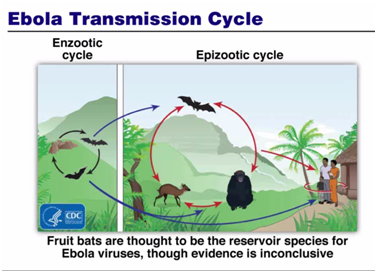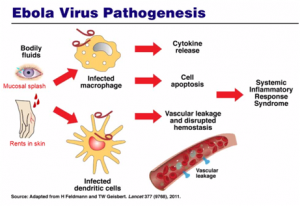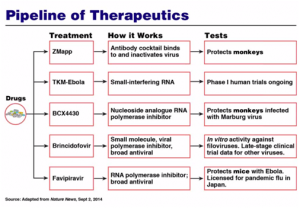Why I (probably) Won’t Catch Ebola
This post is mirrored from the author’s blog The Frawlicking Rambler.
by Robert Frawley
There is a lot of concern about Ebola and rightfully so. It is a terrible disease, spreading exponentially in three West African countries, and to contain the spread we must bring aid to West Africa. The threat is less imminent here in the US though, even with a handful of cases. The virus is deadly, but you can survive with good medical treatment. Regarding transmission, you hear the chances are very low of incidental contact; the things you hear are reassuring but might not make total sense. The virus is different than AIDS, than measles, than Herpes and to understand where to allocate our fear and our resources I thought, why not put some time this week into discussing the virus and how it works.
Where does Ebola come from?
Fruit bats, we think. Bats are not affected by the virus but they can carry it. Humans can contract it from the bats, animals infected by the bats, or other humans. Before 2014 less than 2,000 cases had ever been documented. Typically, interspecies transmission is rare. Most animals do not present with Ebola symptoms though some may carry.

How is it transmitted?
The fluids in which the virus can be present are saliva, mucus, vomit, feces, sweat, tears, breast milk, urine, and semen. Entry points include the nose, mouth, eyes, or open wounds, cuts and abrasions. The virus will be degraded on dried surfaces in a matter of hours, but can be stably maintained in fluids for days. The virus can be eliminated with heating (to 60C) or with lipid detergents.
Close contact is honestly far and away the only way you will likely contract the disease.
Most cases are believed to have come from improper handling of deceased bodies infected with the disease. In the US healthcare workers are likely most at risk, although the CDC has very stringent protocols for care. Now all employees in official Ebola response centers are trained for the situation. The events in Dallas likely only occurred because the hospital had not been specifically trained for handling an Ebola patient.
Once you get it what happens?
The virus works by binding to the surface of cells, entering them, and transcribing their own genome. They contain 7 genes, structural or functional, and make many copies of each. Then, the RNA polymerase gene replicates the genome. Once there is sufficient RNA and protein, the virus self-assembles in the cytoplasm of the host cell, localizes to the membrane, creates an envelope, and travels off to infect other cells.
The virus targets macrophages (immune cells in the blood), liver cells, and endothelial cells (the blood vessel-lining cells). The damage to these cells leads to leaky vasculature, improper clotting, and the release of inflammatory cytokines which cause fever and inflammation. Ebola also contains a protein which blocks STAT signaling under interferons, which normally is responsible for release of anti-viral proteins.
Diagnosis now occurs with RNA measurements for viral genomes (via Polymerase Chain Reaction amplification), protein assays, a pattern of White Blood Cell decrease then spike, and increases in certain liver proteins.

Why can symptoms take up to 21 days?
The latency is due to several factors. One important factor is the initial infection. If it is a very low viral load, the virus might not quickly affect many cells and may latently make its way through the blood stream. Once it begins replicating it still requires considerable growth before symptoms begin. The immune system can immediately detect and fight Ebola with an innate immune response. An adaptive immune response may take longer, especially at low viral load. Once the virus begins compromising immune cells though Ebola can replicate more rapidly. This is when symptoms will begin. Twenty-one days is the longest time to symptoms recorded – most patients will know much sooner.
What treatments work?
The treatments are mostly palliative and depend on the progression of the disease. Blood transfusions and coagulant medicines help, as well as maintenance of electrolytes.
The body creates antibodies to Ebola and deals with it like any other foreign invader. Because Ebola targets immune cells this response is compromised though, and because the hemmoraghic fever can be deadly and weaken the body, often the immune system is not able to recover. Therapies that help reinforce the immune system (new whole blood and plasma, anti-viral drugs) aid the body in fighting the disease. Ultimately in cases where patients are cured, their immune system can eliminate the virus unaided. Blood and plasma transfusions from survivors can be very helpful as they already have antibodies raised against the virus, and the immune response can act faster.
Some drugs are being specifically designed for the Ebola virus, to aid your body in identifying and eliminating it. Zmapp is the most well known right now, and it binds 3 sites on the Ebola glycoprotein. Zmapp has tested very well on primates and has been used on a compassionate-use basis in conjunction with other treatments for patients who have been cured. Other than a few similar drugs in production, there are repurposed anti-virals which have certain activity against Ebola.

If a patient dies, the virus can still carry on in their bodies’ warmth and fluid environment. The viral titer may even increase shortly after death, making the deceased a major risk to family and workers.
Why couldn’t you transmit Ebola without symptoms?
In the period before you have symptoms your viral load is very, very low. There is a small amount of virus in your body but it is undetectable by even our most sensitive techniques. This means the virus has not yet begun to replicate. The virus would be centralized to blood, having not passed through the intact blood vessel barriers, and would be very unlikely to leave the host to a new individual. But it’s not impossible.
After symptoms have left, the disease is controlled by your body’s immune system. Your immune system eliminates all traces of foreign bodies. If you live long enough without symptoms doctors have confidence your body has eliminated all the viral particles. They give you a boost of anti-viral drugs as well.
When the virus begins replicating the results are almost immediate. Endothelial cells are compromised, bleeding can occur, fever sets in because the immune cells detect the virus, even as it is acting on them to replicate itself. The delay between initial viral replication and noticeable symptoms is a matter of very few hours (meaning again, there is a period where viral load is high but symptoms might not be obvious). Without symptoms however, patients are less likely to cough, sneeze, bleed, etc and transmit the virus. Coughing and sneezing are only forms of transmission if there is direct mucal contact.

This is also why contact tracing is so severely important to track down anyone who may have been around the patient in such close confines to possibly contract the virus. So far, most contacts have made it 42 days (twice the maximum incubation period) meaning they did not in those conditions catch Ebola.
Why is Ebola suddenly but transiently in all bodily fluids?
The virus functions by replicating and compromising the cells of your blood vessels. Blood vessels are kept separate from the rest of your body, just allowing nutrients and oxygen to permeate out, and allowing immune cells to get close to sites of invasion. With a break-down of blood vessels the blood comes in direct contact with organs it is not meant to. Your immune system once up to the task can sweep through your whole body and eventually eliminate any trace of the invading virus particles.
With proper treatment, is all the Ebola removed from your body?
Yes. Your body clears all the virus and maintains antibodies to continue fighting it (for as long as possibly 10 years). However, it can remain in some bodily fluids longer than others once symptoms are relieved. See the table below – Ebola can last in sperm after treatment for three months or more.

Check out more good Q&A style posts about Ebola to become more well informed
The CDC Page on Ebola
The New York Times Wellness Section
A great talk by Dr Anthony Fauci, Director NIAID, NIH at the Weill Cornell Medical College Global Health Grand Rounds, October 21, 2014.
And the WHO Factsheet on Ebola
